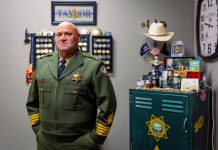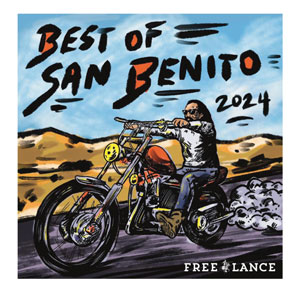Despite many modern inventions, cowboys still ride horses and
twirl rope to bring meat to our tables.
Despite many modern inventions, cowboys still ride horses and twirl rope to bring meat to our tables.
“The rapid changes in technology, however, have forced ranchers to make some necessary changes,” said Mitt French, a fourth-generation owner of the French ranch and manager of the neighboring Las Aguilas and Quien Sabe ranches, about 10 miles east of Hollister, in the Diablo Mountains.
Although DNA testing and all-terrain vehicles have entered the scene, long hours and traditional skills on horseback are still a necessity.
French’s great-grandfather, a Confederate who fled the Union Army in the 1860s, acquired some contiguous parcels of land under the Homestead Act.
At that time, it took the cowboys up to two days to bring their cattle from the hills northeast of Hollister to its railroad station, from which they were transported east to be sold. French remembers his grandfather telling him about a runaway steer taking down a woman’s clothesline as the cattle were moving through Hollister.
In the early 1900s, women’s days could be just as long as men’s. French’s grandmother would get up an hour before the men in order to bake muffins for breakfast, and she had to prepare large meals for all the cowboys.
Shopping itself could take the whole day, considering the time it took to travel to town.
Today, less of a ranching woman’s day is devoted to preparing meals and is more focused on working with livestock.
French’s wife, Janet, and their daughter Jessica play an active role in doctoring, branding and gathering cattle.
The main catalyst for change in ranching is technology.
Gene markers in cattle can be used to create the prime combination that customers desire, such as tenderness and internal fat, known as marbling. Genes that create undesirable qualities, such as excess external fat and fertility problems, are starting to be isolated.
Identification techniques such as these have recently become particularly important in order to combat diseases such as mad cow disease.
Another technological advance has been the widespread use of all-terrain vehicles and horse trailers, which allow cowboys to cover more distance in less time.
Despite the use of these motorized vehicles, most of a cowboy’s day is still spent on horseback.
“You’ll never replace horses with ATVs,” said Colt Barelman, a cowboy who works on the Las Aguilas Ranch.
“In this country, they can’t go the same places as horses can, and you can’t love an ATV,” he added with a smile.
His 10-year-old son Chance noted another benefit, “horses can’t run out of gas,” he said.
The physical demands on cowboys have not changed. The summer is a particularly exhausting season because temperatures can top 100 degrees. In order to beat the heat, Barelman wakes up as early as 3 a.m. Before eating breakfast, he saddles his horse and packs his water and rope, and after breakfast he heads out.
His next meal does not come until dinner. Fellow cowboy Leonard Montes and Barelman are responsible for many miles of fence, which are often knocked down by bulls, fallen branches and bad weather. They cover miles of rough, mountainous territory, which is home to deer, coyotes, bobcats, wild pigs, rattlesnakes and the occasional mountain lion.
The work is so taxing that the cowboys have to give their horses a rest, and they alternate between several horses. All that wear and tear takes a toll on the horses’ shoes, requiring each to be shod every eight weeks: a tough job in itself that requires a strong back and a lot of patience.
French’s children Jessica and Elliot work alongside their parents.
Elliot has been active in rodeo competitions and became the number one high-school bronco rider in California.
His good friend Richie Coefield, who also grew up on the Quien Sabe Ranch, is following in the footsteps of his father, who has been a cowboy for more than 30 years.
When hiring new cowhands, French not only looks for experienced riders, but also for people who are willing to teach their skills to the younger generation.
Jay Jones, a cowboy and accomplished horse trainer, works on the Quien Sabe Ranch, and he has taught French’s 18-year-old son Elliot rein techniques to train horses. Those techniques were taught to him by his father and uncle. Jones uses a gentle but firm manner to produce responsive and obedient horses.
Leonard Montes, who is a Tejon Indian – a tribe which originated near Bakersfield – carries on the tradition of being a cowboy from his father and grandfather. Montes has worked in Oregon, Nevada, Arizona and other parts of California, and attests to this area being particularly family-oriented.
When Montes finds an orphaned calf, he can count on the wife and children of his fellow cowboy to feed it daily when he is at work.
Neighboring ranching families also come together at brandings to help each other out, and here, the ages of the participants can range from eight to 80.
Although the consumption of beef has increased, the economy nowadays relies less upon agriculture, relative to other industries.
Still, cattle ranching is frequently used as a way to protect open spaces from development. It also provides habitat for a variety of wildlife, and the focus remains on preserving what is not just a way of life, but a western heritage.
Anna will be a high school senior at the Convent of the Sacred Heart in Fairfield County, Connecticut. She has spent more than a month every year of her life on the Las Aguilas ranch and is passionate about her experience of riding with cowboys, helping with the training of colts and photographing California ranch life.









